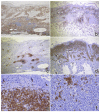Feline and Canine Cutaneous Lymphocytosis: Reactive Process or Indolent Neoplastic Disease?
- PMID: 35051110
- PMCID: PMC8778986
- DOI: 10.3390/vetsci9010026
Feline and Canine Cutaneous Lymphocytosis: Reactive Process or Indolent Neoplastic Disease?
Abstract
Cutaneous lymphocytosis (CL) is an uncommon and controversial lymphoproliferative disorder described in dogs and cats. CL is generally characterized by a heterogeneous clinical presentation and histological features that may overlap with epitheliotropic lymphoma. Therefore, its neoplastic or reactive nature is still debated. Here, we describe clinicopathological, immunohistochemical, and clonality features of a retrospective case series of 19 cats and 10 dogs with lesions histologically compatible with CL. In both species, alopecia, erythema, and scales were the most frequent clinical signs. Histologically, a dermal infiltrate of small to medium-sized lymphocytes, occasionally extending to the subcutis, was always identified. Conversely, when present, epitheliotropism was generally mild. In cats, the infiltrate was consistently CD3+; in dogs, a mixture of CD3+ and CD20+ lymphocytes was observed only in 4 cases. The infiltrate was polyclonal in all cats, while BCR and TCR clonal rearrangements were identified in dogs. Overall, cats had a long-term survival (median overall survival = 1080 days) regardless of the treatment received, while dogs showed a shorter and variable clinical course, with no evident associations with clinicopathological features. In conclusion, our results support a reactive nature of the disease in cats, associated with prolonged survival; despite a similar histological picture, canine CL is associated with a more heterogeneous lymphocytic infiltrate, clonality results, and response to treatment, implying a more challenging discrimination between CL and CEL in this species. A complete diagnostic workup and detailed follow-up information on a higher number of cases is warrant for dogs.
Keywords: PARR; cat; cutaneous lymphocytosis; dog; immunohistochemistry; lymphoma; skin.
Conflict of interest statement
The authors declare no conflict of interest. The funders had no role in the design of the study; in the collection, analyses, or interpretation of data; in the writing of the manuscript; or in the decision to publish the results.
Figures






References
Grants and funding
LinkOut - more resources
Full Text Sources
Miscellaneous

